Emerging Connections
The Feeding Minds and Families Afterschool STEM Program
Small City Partnerships for Informal STEM Learning in Urban Youth
Connected Science Learning October-December 2020 (Volume 2, Issue 4)
By Quyen L. Aoh, Cheyenne L. Barger, and Maile Chang
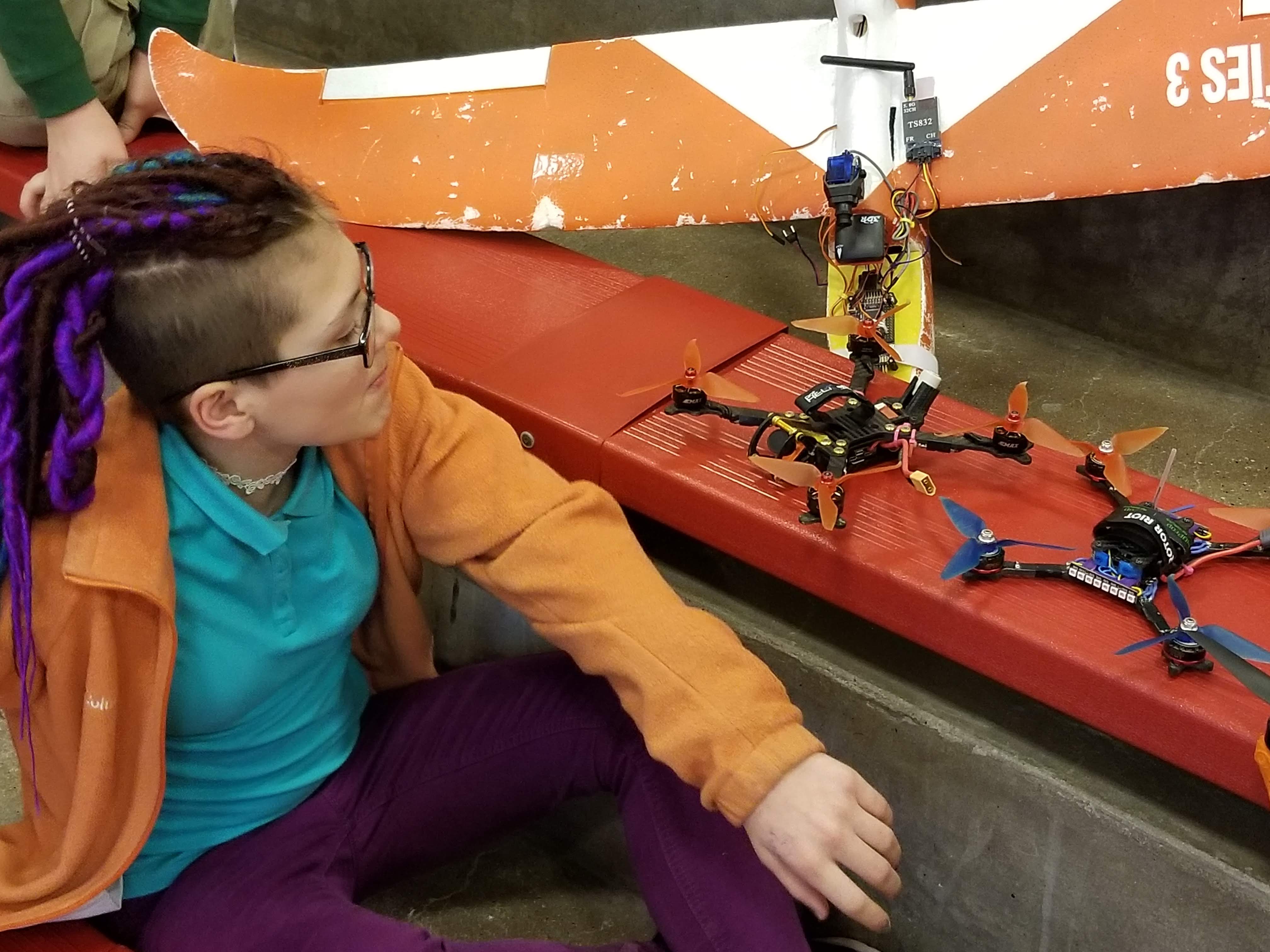
Nationwide there is a paucity of STEM persistence among youth. And while many begin with an interest in STEM, they often lose interest by age 14 (Tai et al. 2006). The risk is compounded for youth who experience inequality due to gender, race/ethnicity, and socioeconomic status (Hill 2018). Persistence is especially low in urban environments, which contain a high proportion of lower-income individuals and people of color. Successful efforts in informal STEM learning (ISL) for urban youth recognize the challenges that prevent persistence, including attending schools that are more likely to be underfunded and under resourced, lower family socioeconomic status, lack of social capital, and stereotypic threats to achievement. Programs such as Techbridge Girls and Youth Alive! address these challenges by deliberately providing low-cost/free programming and opportunities for career exploration, networking with STEM professionals, and family engagement (Migus 2014).
The Challenge of ISL in Small Cities
A study of ISL experiences in urban vs. rural youth suggest that urban youth have higher rates of participation in afterschool science clubs and science experiences overall (Hill et al. 2018). This is not surprising given that urban environments likely have more museums and other ISL spaces, institutions of higher education, and STEM industries than rural areas, increasing the likelihood that all citizens have access to multiple ISL environments.
However, urban environments vary in scale and trajectory. Small cities (populations less than 100,000) must meet the challenge of ensuring STEM persistence in youth often without the advantages that come from having numerous large, STEM-based anchor institutions and industries nearby. Small legacy cities—located throughout the United States but concentrated in the Midwest “Rust Belt” region—can be particularly challenged. These cities grew significantly until the mid-20th century on an economy of manufacturing and labor jobs that did not require higher education. Since then many have been in decline (Hollingsworth et al. 2017). While some have been able to reverse this decline and bring substantial resources to bolster STEM persistence, many continue to flounder.
Erie, Pennsylvania, is a paradigm of a small Rust Belt city that exhibits the STEM persistence challenge. Its population declined as manufacturing plants closed or downsized. The city has high unemployment and poverty, especially among minorities and those without a college degree (Table 1). It lacks proximity to other major metropolitan areas and has four small, regional universities (including Gannon University) and one Fortune 500 company (Erie Insurance). There are several small nature centers but these are not located within the city limits.
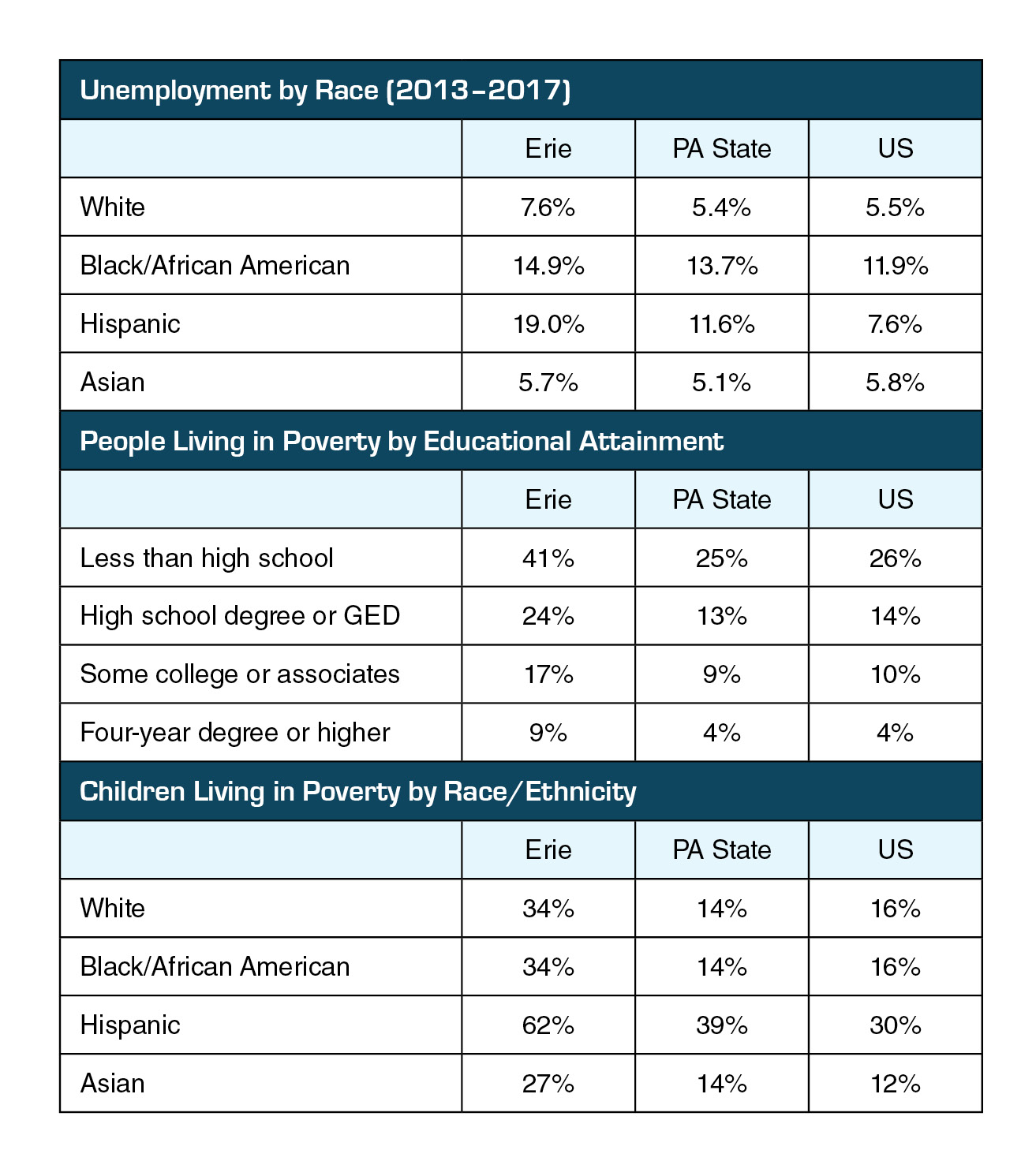
The city’s youth are the region’s most ethnically diverse, minoritized, and socioeconomically disadvantaged (Table 2). Compared to the youth in the surrounding county who are on average less than 10% non-white and 45% economically disadvantaged, youth in the city’s public middle schools are majority non-white (60%) and disadvantaged (79%). City youth have significantly lower levels of math and science proficiency than youth in the surrounding schools, three of which rank in the top 10% in Pennsylvania. Reduced funding has led to a dearth of afterschool programming, especially in STEM. Thus, Erie’s youth have few ISL opportunities and are highly vulnerable to losing STEM interest.
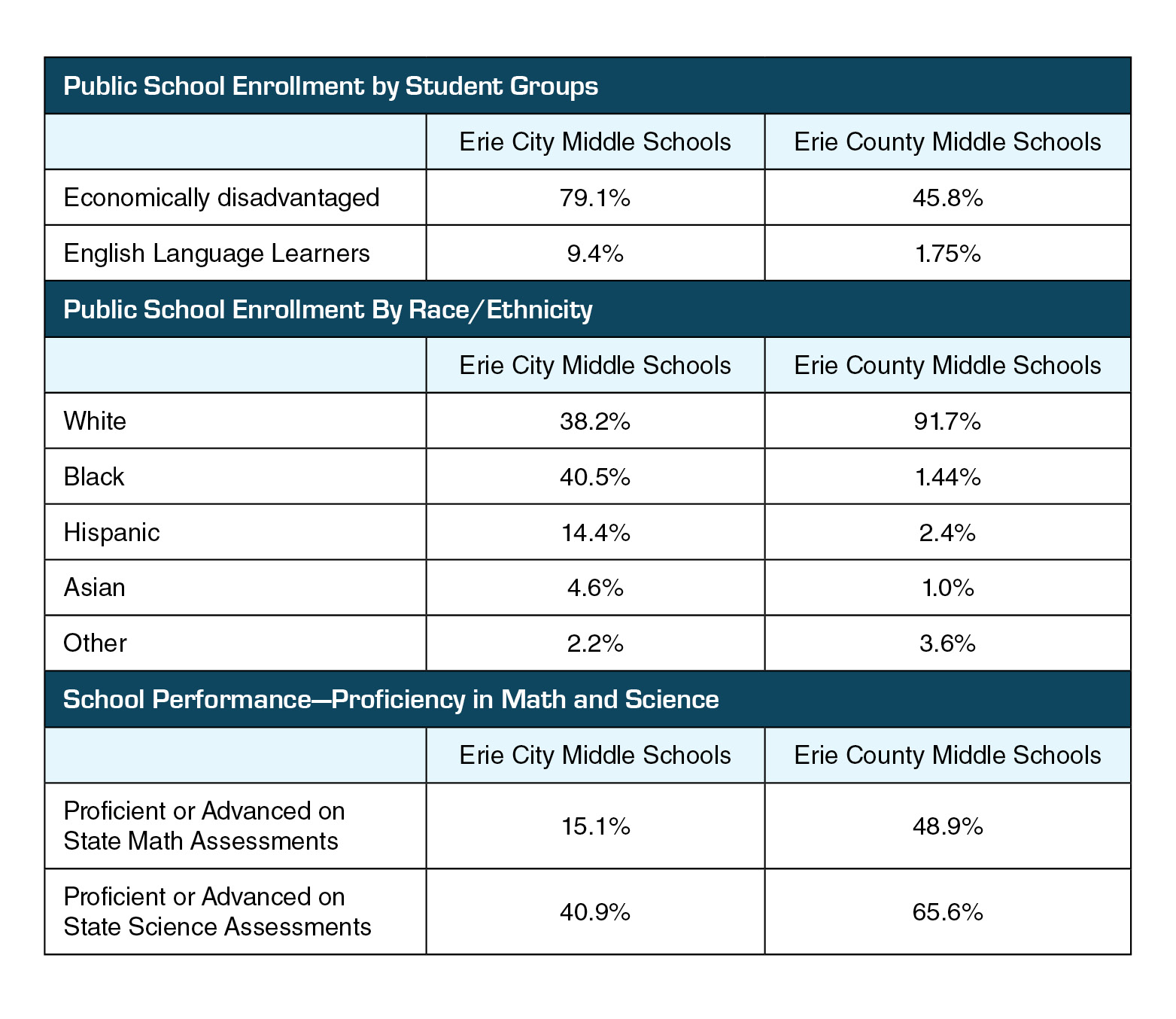
Despite these challenges, Erie has advantages that can be leveraged to support ISL for its youth.
- Erie has hundreds of small STEM-based industries (<250 people) that collectively provide the largest source of income and second largest source of jobs in the region (Wertz and Wood 2015).
- Networking across public and private sectors is relatively easy in a small city. Indeed, we found little difficulty in accessing people and resources needed to facilitate our program.
- Vibrant neighborhood revitalization organizations have helped cultivate and support volunteerism, particularly toward projects that benefit the city’s schools.
- The local United Way’s Community School initiative formalizes collaborations between the public and private sector to boost educational and family support resources for urban families so that schools can serve as a place where “services, supports, and opportunities lead to improved student learning, stronger families, and healthier communities” (Samberg and Sheeran 2000). As described in the Erie School District’s Strategic Plan, each community school has a corporate partner providing financial support and a lead partner providing administrative and organizational support. Gannon University is the lead partner for Strong Vincent Middle School, one of three public middle schools in Erie.
- Gannon’s involvement in the community provides a final advantage. Its university mission of excellence in service and 2017–2020 Strategic Plan are reflected in its ongoing service to Erie, including facilitating a successful prep program GoCollege, service-oriented alternative spring breaks, service learning, and establishment of the Our West Bayfront neighborhood organization. Gannon’s service to the city and to Strong Vincent Middle School in particular then provides a natural avenue for the development of the Feeding Minds and Families program.
Overview of the Feeding Minds and Families (FMF) Afterschool STEM Program
Gannon’s 2017–2020 Strategic Plan included two major goals relevant to this project: Create public impact and promote learning by engagement. The FMF program began in fall 2018 to serve Erie youth (age 11–14) and their families by making ISL fun, accessible, family-minded, and locally relevant. Its long-term goal is to broaden participation, interest, and exposure to STEM and STEM-related careers. The program capitalizes on the region’s existing resources, networks, and family engagement and was funded by a Public Engagement Grant from the American Society for Cell Biology. Essential to this program are a number of volunteer and staff roles (Table 3).
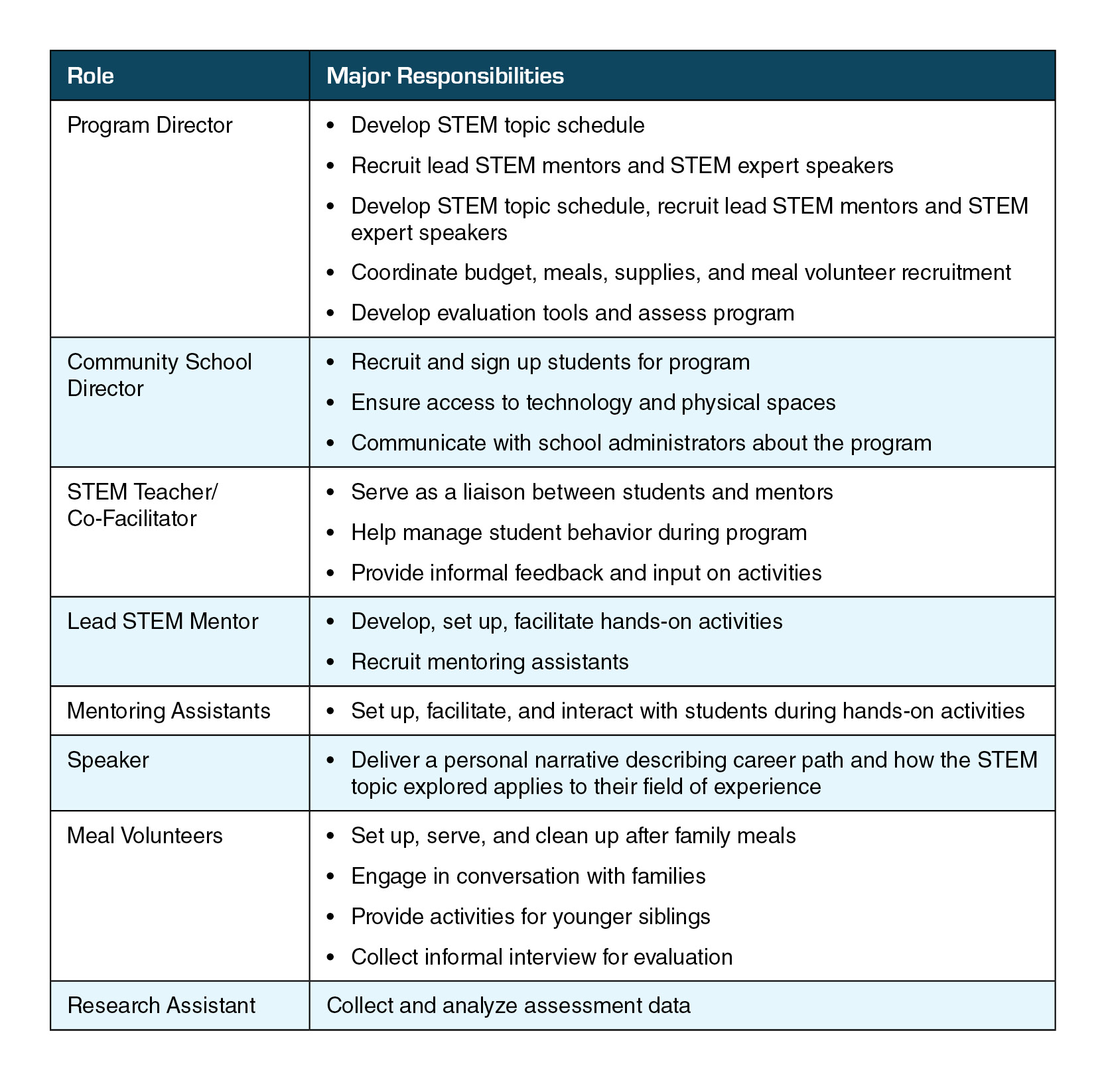
The afterschool program has been offered at Strong Vincent and East Middle Schools, two of the three Erie middle schools. It is open and free to all youth at those schools and meets once per week for six weeks. In each weekly session, youth first take part in hands-on activities. The topics, such as nanotechnology and mobile technology, reflect local STEM industries and research interests (Figure 1 and Table 4).
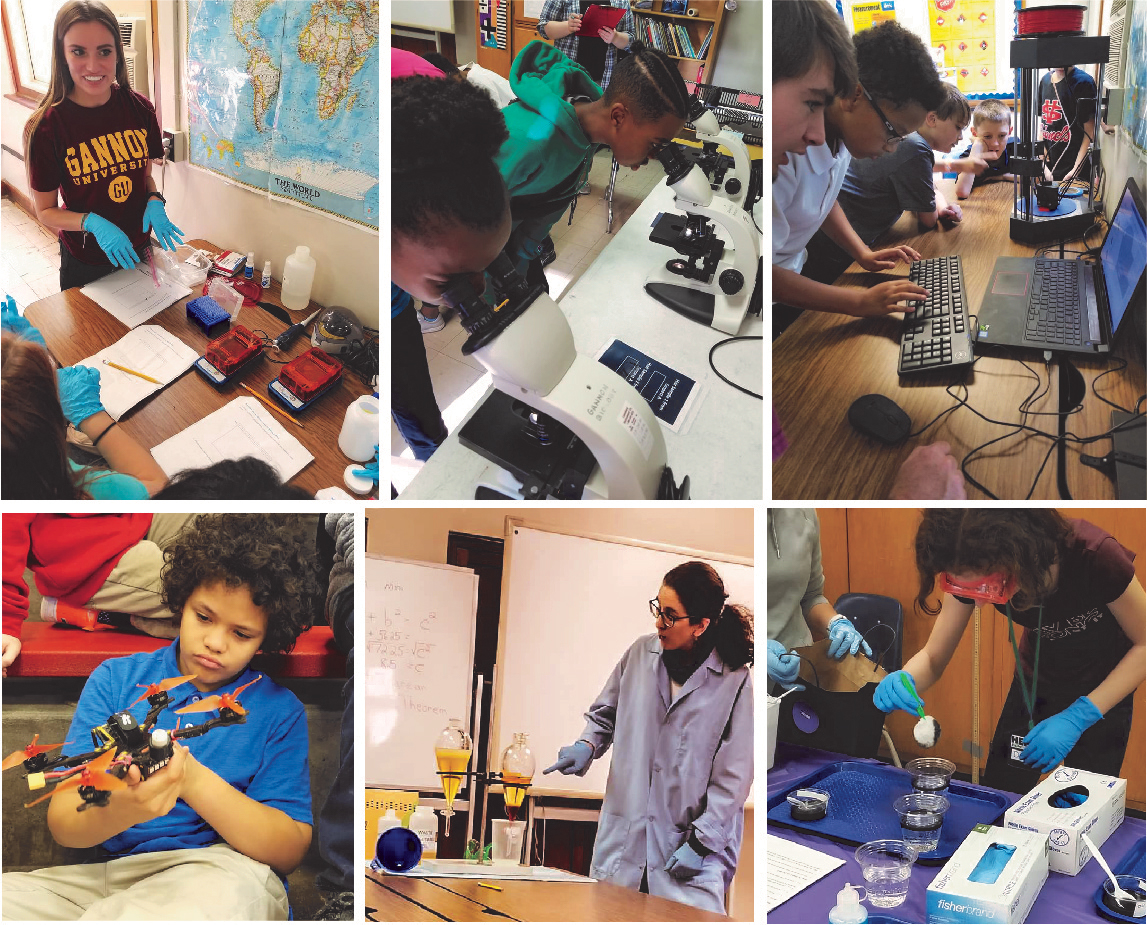
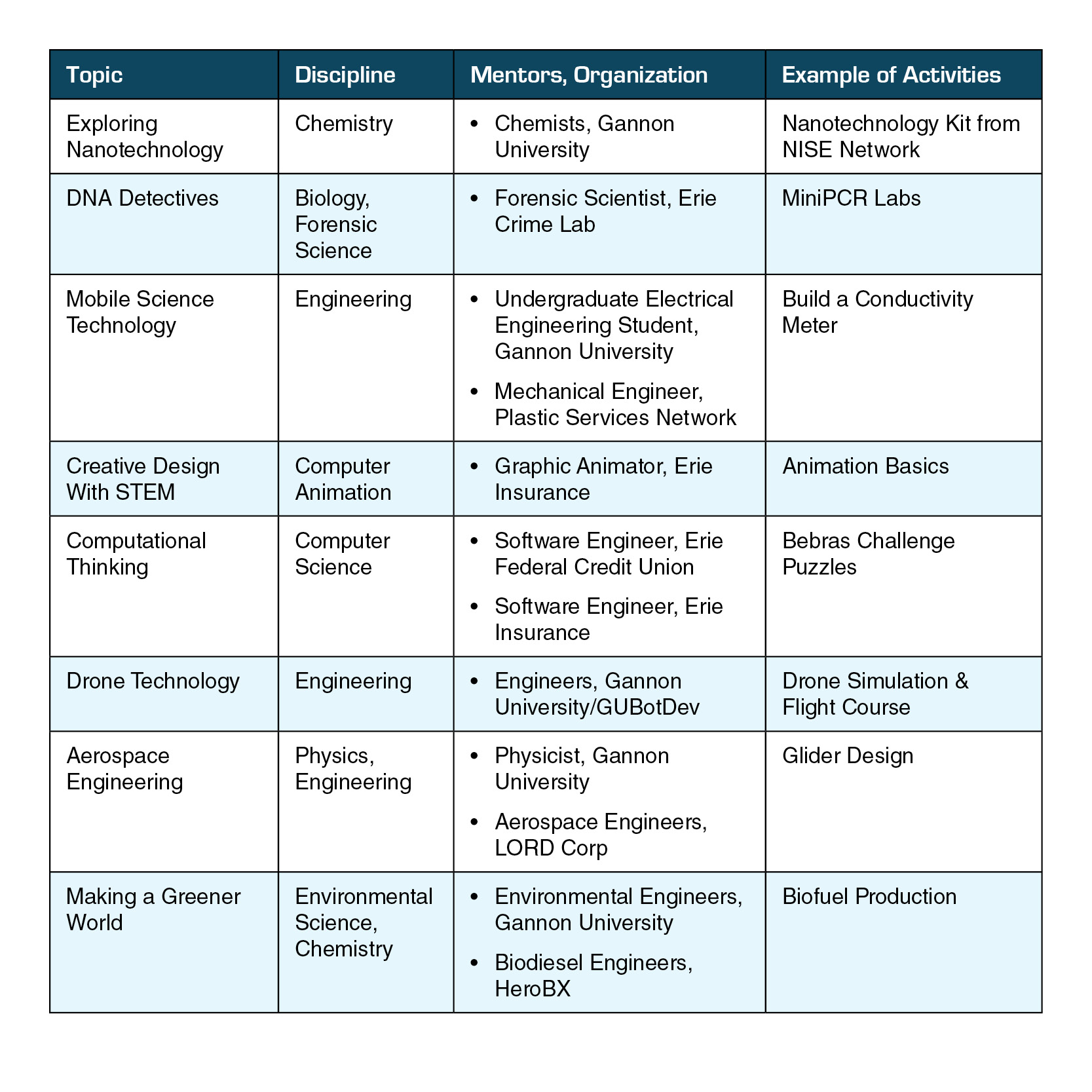
Following the STEM activity, youth and their families are invited to a family dinner, which serves three important functions:
- The meal engages families. Youth who are supported at home to stay interested in STEM or to enter a STEM career are more likely to persist in STEM (Archer et al. 2012; Dewitt and Archer 2015). Therefore, the program provides a way for families to dialogue about STEM.
- The meal meets a basic need for families, some of whom may have food insecurity.
- Further, families increase their social capital by getting to know local STEM experts. In particular, a speaker shares a personal narrative during the dinner about their career path and how the topic explored applies to their field of expertise (Figure 2).

Staff and Volunteer Roles and Responsibilities
Program development, logistical and financial planning, and implementation were carried out by the program director. Initial development was done in collaboration with each school’s Community School Director (CSD). The CSDs recruited students and managed the responsibilities of hosting an afterschool program with an external group, ensuring safety and providing access to technological and physical resources and space to hold the program and store supplies. Discussions with the CSDs allowed us to consider how to adapt our practices to their student population’s strengths and challenges. For example, at one school where parent involvement was lower, having the CSD reach out to remind parents of meals was important to encourage family participation. CSDs were encouraged to and nearly always attended the dinners, engaged in conversation with participants, and helped serve and clean up the meal. CSDs then served as invaluable liaisons between the schools, families, and our program.
We also enlisted one or two STEM teachers from each school to act as program co-facilitators. The teachers attended every week and were compensated with a small stipend. While they did not develop curriculum or lead activities, they provided participants a sense of familiarity, trust, and authority that would not have been possible on our own. During each session, teachers assisted the mentors by walking around and interacting with students, encouraging them, asking follow-up questions, and helping to manage student behavior. Through these actions, the teachers helped familiarize mentors with behavioral norms typical of the student population and modeled how to encourage and connect with students. This especially helped mentors who had limited youth mentoring experience or were not familiar with this student population, leading to a more inclusive atmosphere for program participants. Finally, these teachers provided feedback on what practices, topics, and activities were most successful and which ones could be improved.
A key strategy used to support interest in STEM and STEM careers is that all staff and volunteers are expected to mentor and interact with youth and their families. STEM professionals, such as university faculty and industry workers, serve as lead mentors and speakers. These individuals are recruited through networks within Gannon, meeting with leaders in STEM-based industries, and through personal networks, such as faith-based communities. Often, recruiting one expert would lead to identifying additional experts likely to participate in the program.
The lead mentor, in consultation with the program director, developed the hands-on activities over several weeks or months. As general guidelines, we asked mentors to develop three to five activities that could be done in small groups, with each activity focusing on a single learning objective. In addition, they should allow for some variability to encourage critical thinking and teamwork to develop their social skills. The program director helped ensure that activities met the suggested guidelines and were engaging, relevant, and age-appropriate. To ensure a low student-to-mentor ratio, we asked our lead mentors to enlist additional STEM experts and trainees as mentoring assistants. The majority of our mentors were excited to do so, especially when they could involve others from their own team or organization. Mentoring assistants included trainees (i.e., undergraduates majoring in STEM or STEM-related fields) and STEM professionals.
An additional STEM expert was recruited to speak during the dinners. The speakers ranged from executives to newly graduated STEM workers. In general, we tried to avoid having the lead mentor also serve as speaker considering the intensive nature of the hands-on activities and four-hour length of our program. Speakers delivered a 15- to 20-minute personal narrative that described their career path and trajectory, and related how the day’s topic applied to their current position and responsibilities. Speakers also emphasized career steps that deviated from the expected norm so that participants would better appreciate how varied and unconventional STEM career paths can be.
To eliminate barriers to participation and provide a welcoming space, meal volunteers set up, serve, and clean up the family meals. However, meal volunteers also helped create a welcoming space by interacting and having conversations with youth and families. When parents walked in, volunteers immediately greeted them. Volunteers ate and conversed with parents and youth, often steering the conversation to STEM while getting to know them. Some volunteers served repeatedly and established comfortable relationships with the families while others were STEM trainees and could discuss STEM. Moreover, these conversations were our avenue for collecting data about youth and their families’ perspectives and assessment of the program.
Meal volunteers also helped with younger siblings by assisting parents in getting meals for their children and providing STEM activities to engage them while parents were listening to the speaker, eating, or conversing with their middle school youth or other adults. Many parents appreciated our foresight in providing a supportive environment for families to participate in this part of the program. Recruiting and coordinating meal volunteers was done through Get Connected, a free community volunteer website developed by United Way of Erie County and The Nonprofit Partnership. Volunteers were recruited from the general public, but often a group, such as a student club or local business, would volunteer together.
To support ongoing assessment and iterative development, we enlisted undergraduates from Gannon’s Biology and Education departments to serve as research assistants. These assistants collected data during the hands-on activities and family meal, and assisted in reviewing and analyzing the data.
Pilot Data
Table 5 provides a summary of participation. We collected data about the program’s effectiveness through two methods: observation and an informal survey. Both tools were developed with the assistance of an advisor from the Center for Research and Evaluation (CRE) in Columbus, Ohio. The advisor was assigned to the program director through the ASCB Public Engagement Grant. The observation tool was adapted from the Dimensions of Success Observation Tool from the Partnerships in Education and Resilience (PEAR) Institute (2017). This tool was used to record observational data about the level of interest and engagement, STEM content learning and practices, and effectiveness of mentors in managing and facilitating the activities. Research assistants were trained on how to record data by the program director.
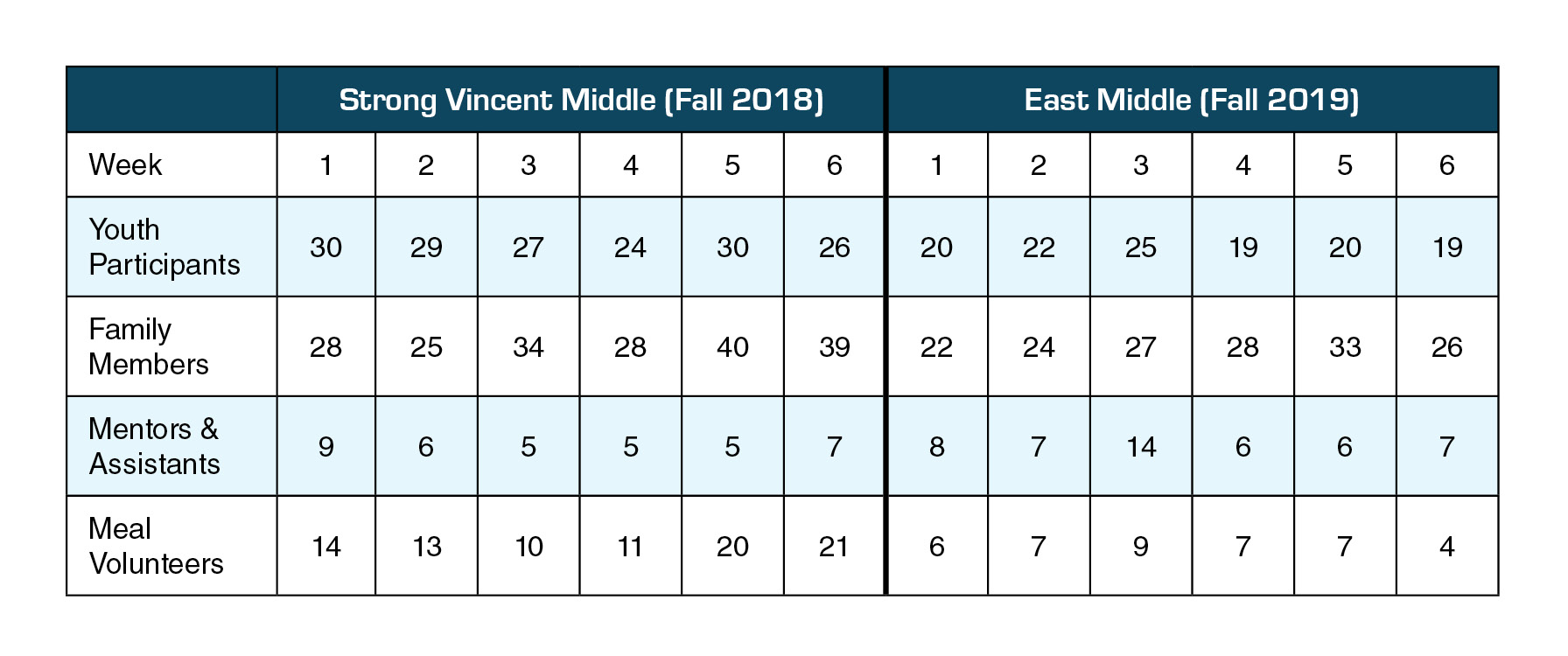
A second method for collecting data was informally surveying students and families during the dinner portion of the program. Meal volunteers and mentors were given specific questions to ask participants about their impressions of the session, what they learned, and whether they knew of/had access to other ISL resources. They were instructed to ask these questions informally during their conversations throughout the dinner. At the end of the evening, volunteers and mentors use a survey form to record the data, provide suggestions for program improvement, and share how participating affected their ability to communicate with the public about STEM. At the end of the program, the observation and survey data were aggregated and analyzed for short-term outcomes, as recommended by the CRE advisor. The results were discussed with the advisor to ensure appropriate conclusions. Based on these data, the following outcomes were obtained.
(1) Youth and families found the STEM topics, activities, and talks fun, interesting, and relatable.
Students found the program enjoyable and often at the end of the program asked when it would begin again. Families commented that they wish the program was year-round. Many students had “perfect attendance.” When asked what their favorite session was, all sessions were represented by at least some students. Participants also found the topics relatable. For example, during spring 2019, youth performed geographic information system mapping using cell phones to help determine the walkability of the school area surroundings. The speaker explained how this data was integrated to provide valuable community information. Some families even approached the speaker to discuss these findings. In fall 2019, youth commented that they learned that nanotechnology is present in everyday materials and that some have health benefits. In general, we found that providing multiple, short 15- to 20-minute group activities with minimal lecture promoted interest and engagement.
(2) Youth and families expressed or became more interested in STEM-related career options.
Youth comments about STEM careers were observed in multiple sessions, including sessions on drones, 3D printing, and mobile technology; however, STEM career comments didn’t occur in every session for several reasons. First, we focused on building interest and not on emphasizing career options during the STEM activities. Second, we do not expect middle school students to actively explore career options. Nonetheless, on occasion a particular activity would pique a student’s interest in a specific career. During a session on computer animation, one student spent the entire dinner conversing with the lead mentor, a graphic computer animator, and asked numerous questions about the technology and how to learn more about computer animation. In contrast to the STEM activity, our goal for the dinner was to increase parents’ and older adults’ awareness of career options and other ISL opportunities. Survey comments suggest that parents were intrigued by the career options they heard. For example, during a session on drone technology and piloting, parents commented that they did not know there was a pilot shortage and some expressed interest in the local flight school’s summer camp. These outcomes suggest that programs like FMF can help initiate early STEM career interest in youth.
(3) Participants increased their social capital and knowledge of local STEM industries and resources.
Comments like “I didn’t know we had that in Erie” were made by youth, families, mentors, and even meal volunteers on several occasions. Some were surprised and appreciated learning about STEM industries that contributed to the local economy. During dinners, families were given access to a network of professionals and trainees that could answer questions about STEM and STEM careers. Equally important, all mentors and speakers sat with and took an interest in the families during dinner. Many mentors commented they would like to volunteer again. Families also learned about nearby resources such as the public library’s Maker Lab and regional summer camps.
(4) Improved confidence in science communication and public engagement of science.
We recruited lead mentors, mentoring assistants, and speakers from local industries and universities. Many mentors commented that participation improved their confidence and/or ability to communicate STEM to youth and non-scientists. Even meal volunteers—many of whom would not identify as STEM professionals—felt their ability to communicate about STEM topics improved. These results suggest that this model may increase public engagement with science, which is characterized by mutual learning and multi-directional dialogue among a diverse group of participants (McCallie et al. 2009).
Keys to Success: Partnerships and Collaboration
This program supports that small cities can leverage collaboration and local resources to implement ISL programs that introduce youth to a broad range of STEM fields, professionals, and careers. Using our networks, we established partnerships to deliver a unique program and meet our volunteer needs. Indeed, our close collaboration with CSDs, teachers, local organizations and businesses, university offices, departments, and student groups truly made this a communal success (Table 6).
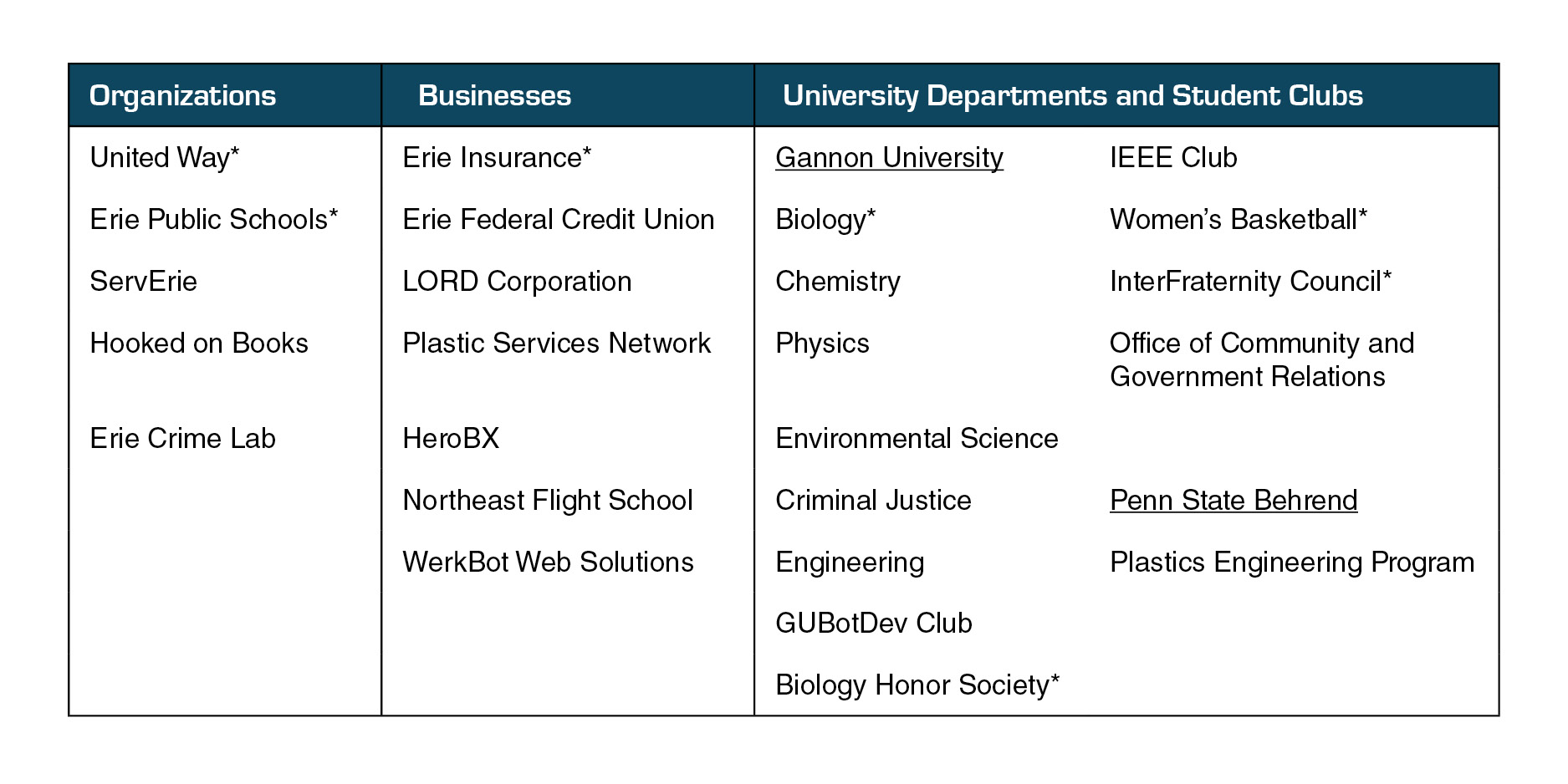
Each of these partnerships contributed to the success and development of the program. Gannon’s Office of Community and Government Relations helped establish partnerships with the United Way and Erie Public Schools to implement the program, and provided volunteer recruitment support and event planning expertise. The United Way’s CSDs ensured that we had classroom and dining spaces that were safe and accessible for participants. STEM teachers also gave us access to classrooms, storage spaces, and supplies. We were able to provide a wide breadth of topics because we recruited STEM experts across multiple disciplines and societal sectors. Donations, such as books on STEM from Hooked on Books, were provided free of charge to enhance self-led learning. Together, these partnerships helped establish the program as a solid and effective means to promote ISL.
We have seen the positive impact the program has had on the families served, mentors, and volunteers. Mentors saw firsthand the potential in a youth population that was marginalized in many ways. Each program introduced more mentors and volunteers into the practice of ISL and opened up avenues for local businesses and organizations to contribute to urban youth development. The program was used as an avenue for service learning for at least two university courses. Through the collective efforts of all involved, we have shown that this model is feasible and leverages the many strengths of a small city like Erie.
Continued Areas of Development, Future Directions, and Tips for Implementation
Our collaborative ISL program increases STEM engagement and interest for urban youth and their families. However, engagement and interest primarily address motivation, not necessarily the STEM knowledge and practice also required for persistence. Moving forward, our focus will be identifying practices that promote STEM knowledge and practice in our youth. Throughout the pilot program, we used our observation tool to collect preliminary data on the various methods mentors employed to promote knowledge and practice. This data will be used to build a model of best practices and a rubric to assess our activities’ learning outcomes.
We hope to expand to other middle schools in the region. This expansion does present logistical challenges. Specifically, how to coordinate multiple programs within an academic year so that all middle schools will benefit annually but without overextending mentors. Expansion will require that we identify new topics, develop additional activities, and increase our mentor and speaker pool. Given the large number of local STEM faculty and industries, it is unlikely that we have exhausted our pool of topics, mentors, and speakers.
We hope that small and large cities will be able to use this model to promote STEM learning and community building. The major investments and costs are a program director that can provide adequate coordination and leadership, and a pool of STEM experts and volunteers. Funds to support activity supplies, stipends, and meals must also be considered. However, costs can be reduced by soliciting donations from organizations and local businesses, such as restaurants for meals. Our results show though that investing in this type of program is well worth the effort for the benefits it can produce for urban youth and their families.
Quyen Aoh (aoh001@gannon.edu) is an Associate Professor in the Department of Biology at Gannon University in Erie, Pennsylvania. Cheyenne L. Barger is a master's degree student studying Community Health and Health Behavior at the University in Buffalo, New York. Maile Chang is a senior majoring in Biology and Secondary Education at Gannon University in Erie, Pennsylvania.
citation: Aoh, Q.L., C.L. Barger, and M. Chang. 2020. The Feeding Minds and Families Afterschool STEM Program: Small city partnerships for informal STEM learning in urban youth. Connected Science Learning 2 (4). https://www.nsta.org/connected-science-learning/connected-science-learning-october-december-2020/feeding-minds-and
Inclusion Interdisciplinary STEM Middle School Informal Education


